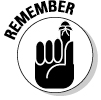Chapter 18
Practice Exam 2
Like the actual, computer-based GRE, the following exam consists of two 30-minute essays, two 30-minute Verbal Reasoning sections (20 questions each), and two 35-minute Quantitative Reasoning sections (20 questions each). The actual GRE may also include an extra Verbal or Quantitative Reasoning section, which doesn’t count toward your score, but this practice exam has nothing like that.
Take this practice test under normal exam conditions and approach it as you would the real GRE:
 Work when you won’t be interrupted.
Work when you won’t be interrupted.
 Use scratch paper that’s free of any prepared notes. On the actual GRE, you receive blank scratch paper before your test begins.
Use scratch paper that’s free of any prepared notes. On the actual GRE, you receive blank scratch paper before your test begins.

 Answer as many questions as time allows. Consider answering all the easier questions within each section first and then going back to answer the remaining, harder questions. Because you’re not penalized for guessing, go ahead and guess on the remaining questions before time expires.
Answer as many questions as time allows. Consider answering all the easier questions within each section first and then going back to answer the remaining, harder questions. Because you’re not penalized for guessing, go ahead and guess on the remaining questions before time expires.
 Set a timer for each section. If you have time left at the end, you may go back and review answers (within the section), move on and finish your test early, or kick back and relax until time expires.
Set a timer for each section. If you have time left at the end, you may go back and review answers (within the section), move on and finish your test early, or kick back and relax until time expires.
 Don’t leave your desk while the clock is running on any section.
Don’t leave your desk while the clock is running on any section.
 Take a one-minute break after each section and the optional ten-minute break after the first Verbal section.
Take a one-minute break after each section and the optional ten-minute break after the first Verbal section.
 Type the essays. Because you type the essays on the actual GRE, typing them now is good practice. Don’t use software, such as Microsoft Word, with automatic spellchecker or other formatting features. Instead, use a simple text editor, such as Notepad, with copy and paste but no other features. The GRE essay-writing field features undo, redo, copy, and paste functionality but nothing else.
Type the essays. Because you type the essays on the actual GRE, typing them now is good practice. Don’t use software, such as Microsoft Word, with automatic spellchecker or other formatting features. Instead, use a simple text editor, such as Notepad, with copy and paste but no other features. The GRE essay-writing field features undo, redo, copy, and paste functionality but nothing else.
After completing this entire practice test, go to Chapter 19 to check your answers with the answer key and go through the answer explanations to all the questions, not just the ones you miss. The answer explanations provide valuable insight — material that provides a good review of everything you went over in the previous chapters. Reviewing answer explanations to all the questions also ensures that you understand the reason why any answers you guessed correctly are correct.
Answer Sheet
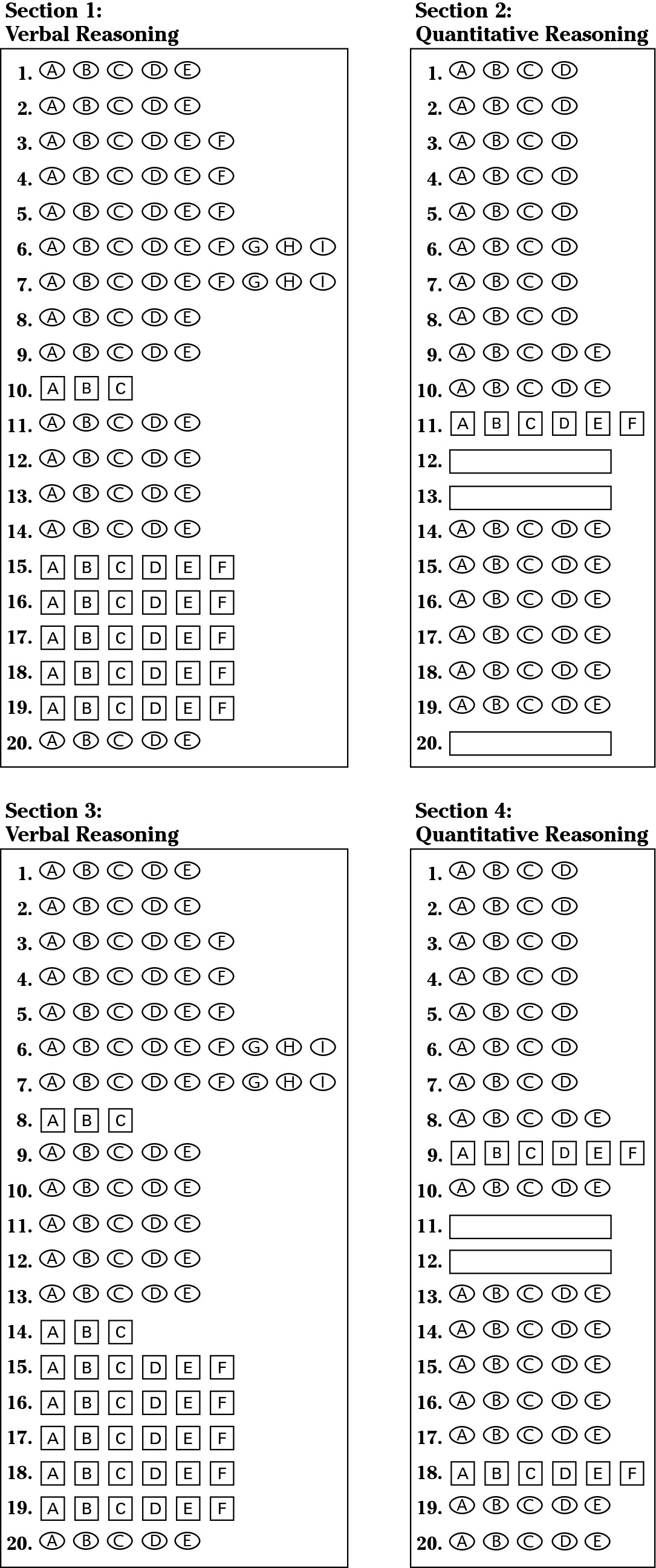
Analytical Writing 1: Analyze an Issue
Time: 30 minutes
Directions: Present and explain your view on the following issue. Although there is no one right or wrong response, be sure to consider various points of view as you explain the reasons behind your own perspective. Support your position with reasons and examples from your own reading, personal or professional experience, and observations.
“Equal opportunity means parity in pay. Everyone should not earn the same amount of money, but it’s ridiculous to see an athlete earning tens of millions of dollars in a single year while the average household income is slightly more than $50,000.”
Express the extent to which you agree or disagree with the preceding statement and explain the reasoning behind your position. In support of your position, think of ways in which the statement may or may not be true and how these considerations influence your position.
Analytical Writing 2: Analyze an Argument
Time: 30 minutes
Directions: Critique the following argument. Identify evidence that strengthens or weakens the argument, point out assumptions underlying the argument, and offer counterexamples to the argument.
“More and more cities and towns are installing red light cameras to catch red light runners in the act. In 2008 alone, red light running accounted for 762 fatal crashes in the United States and 137,000 injuries. A study conducted by the Federal Highway Administration attributed a 25 percent reduction in T-bone accidents at intersections to the installation of red light cameras. Because people fail to voluntarily honor the law, these traffic cameras are essential in enforcing these laws and protecting public safety.”
Discuss the merits of the preceding argument. Analyze the evidence used as well as the general reasoning. Present points that would strengthen the argument or challenge it.
Section 1
Verbal Reasoning
Time: 30 minutes for 20 questions
Directions: Choose the best answer to each question. Blacken the corresponding oval(s) on the answer sheet.
Directions: For Questions 1–7, choose the one entry best suited for each blank from its corresponding column of choices.
1. During the funeral service, mourners sang a _____.
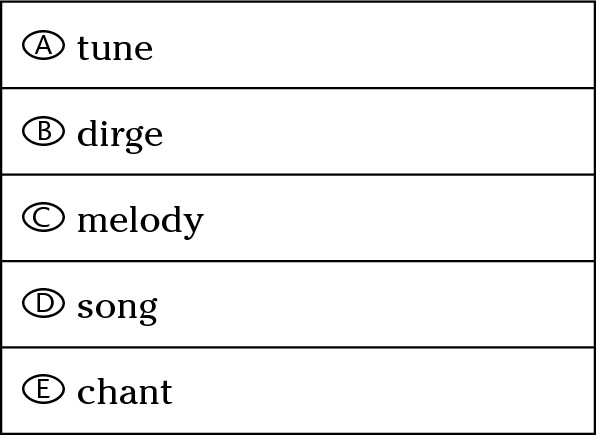
2. During the meeting, Gwendolyn became upset and launched into _____ about how unfair it was to cut pay as living expenses increased.
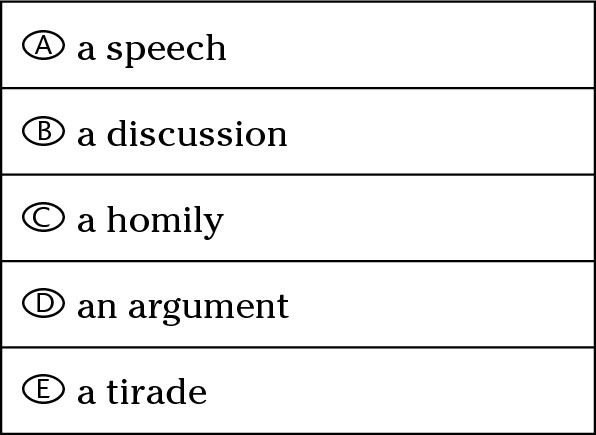
3. Although the (i)_____ system typically can detect only five different tastes, individuals with a more (ii)_____ palate are capable of distinguishing subtle differences in even the most similar foods.
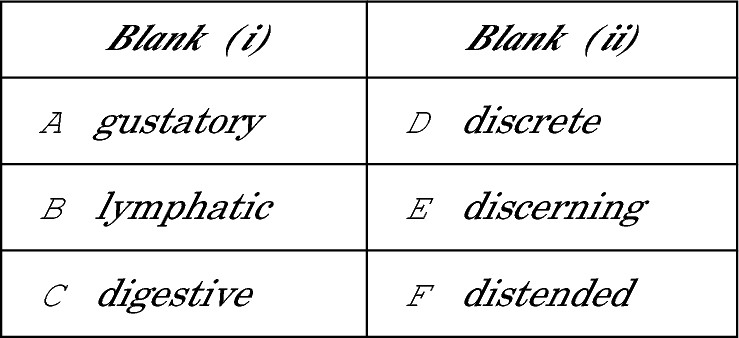
4. The latest tsunami (i)_____ the small seaside resort. Fortunately, no lives were lost, and the loss of property served as a (ii)_____ for a much needed renovation.
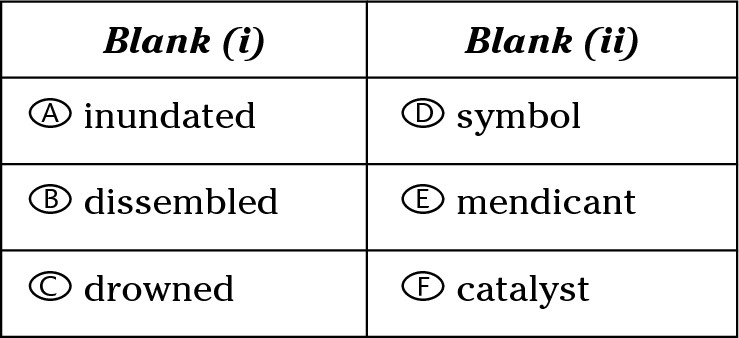
5. The castle walls were (i)_____ to attack. After several unsuccessful assaults, the enemy’s enthusiasm began to (ii)_____, and the troops dispersed.
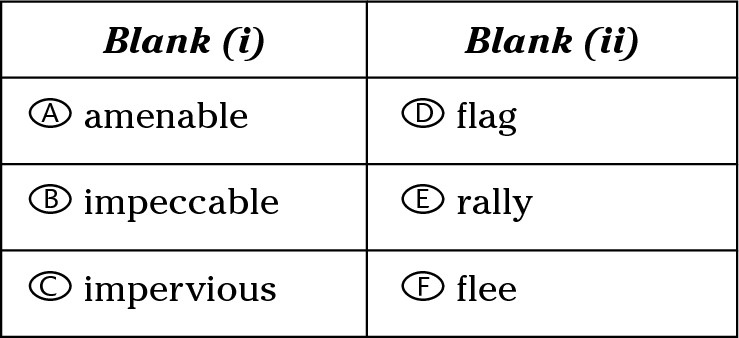
6. Aware of the (i)_____ national debt, congress passed legislation to impose a strict (ii)_____ program to (iii)_____ spending.

7. The (i)_____ between the man’s demeanor and his account of what he was doing at the time of the crime made police officers suspicious, but with so much of the evidence (ii)_____, their case against him was (iii)_____ at best.

Directions: Each of the following passages is followed by questions pertaining to the passage. Read the passage and answer the questions based on information stated or implied in that passage. For each question, select one answer choice unless instructed otherwise.
In a poll conducted by Washington Post-ABC News, 70 percent of Americans support the use of passenger profiling to determine which passengers are most closely scrutinized at airports. They believe that the cost savings and added convenience for a large majority of passengers is worth the questionable practice of singling out a minority of passengers for closer scrutiny. In addition, passengers feel that pat downs and full body scans are highly invasive.
When most Americans discuss profiling, they are referring to profiling based on race, nationality, religion, and gender, which many people consider a civil rights violation. However, most experts agree that profiling in this way is inefficient and ineffective. They recommend profiling by behavior and intelligence, using no-fly and watch lists, personal data, travel histories, and so forth to identify potential threats.
Civil liberty organizations claim that this solution is no better and perhaps worse in terms of violating civil liberties, because it gives government agencies license to collect sensitive information on any and all citizens. They believe that the only fair solution is to inspect all passengers and luggage.
When it comes to airport security, ultimately we face a choice. Either we protect civil liberties and accept the cost and inconvenience of inspecting all passengers and luggage, or we relinquish our civil liberties or the civil liberties of certain groups or individuals to reduce costs and streamline baggage and checkpoint inspections.
8. According to experts, which of the following is most effective in ensuring airline security?
A Profiling passengers based on race, nationality, religion, and gender
B Inspecting all passengers and their luggage
C Profiling by behavior and intelligence
D Interviewing all passengers before boarding
E Streamlining baggage and checkpoint inspections
9. Which of the following, if true, most effectively undermines the argument that the only choice we have is between security and civil liberties?
A Bomb-sniffing dogs are more effective and less intrusive at detecting explosives than human inspectors or expensive devices.
B A combination of profiling and targeted interviews has proven most effective and efficient.
C Precertification as a safe flyer significantly improves efficiency at checkpoints.
D Checked baggage is more likely than carry-on luggage to contain explosives.
E No security measures are 100 percent effective.
The following passage is an excerpt from Causes of War by Jack S. Levy and William R. Thompson (Wiley-Blackwell).
It is hard to imagine what life would have been like in the late twentieth century in the absence of World War I and World War II, which had such profound effects on the global system and on domestic societies. The same can be said for the Cold War. For nearly a half century it shaped both international and domestic politics and cultures, not only in the United States and the Soviet Union, but also in Western Europe and the Third World (Weart, 1989). The development of new states in the contemporary era continues to be influenced by warfare and preparations for war. With the proliferation of nuclear weapons, and with the threat of the acquisition of nuclear weapons by terrorist groups and “rogue states,” new threats to the security of even the most powerful states in the system have emerged. The proliferation of civil wars and conflicts involving “non-state” actors has changed life throughout the developing world. A better understanding of the causes of war is a necessary first step if we are to have any hope of reducing the occurrence of war and perhaps mitigating its severity and consequences.
For the following question, consider each answer choice separately and select all answer choices that are correct.
10. According to the passage, which of the following are effects of war and preparations for war?
A Reshaping of international and domestic politics and cultures
B The proliferation of civil wars and conflicts
C Development of new states
For Questions 11–13, select only one answer choice.
11. One could reasonably infer from this passage that the greatest security threat is which of the following?
A Proliferation of civil wars
B Terrorists
C Rogue states
D The Cold War
E Proliferation of nuclear weapons
The following passage is an excerpt from UnMarketing: Stop Marketing. Start Engaging. by Scott Stratten (Wiley).
To successfully UnMarket your business, your goal should be to get to the point where you are a recognized expert in your field. You can choose to be recognized for a certain discipline, whether it is time management or sales or marketing in general. You can also aim to be recognized as an expert to a specific industry. What you have to realize is that there is an important difference between somebody who is selling something and somebody who is an expert. This is one of the problems when you use advertising or direct mail for your marketing — if your potential customer does not have an immediate need for your product or service, then you are potentially turning them off and losing them for the future. When you position yourself as an expert with useful information for people, your marketplace will always have a need for that information. You have successfully pulled people into your funnel, you have their attention, and now you need to do something great for them.
12. Which of the following sentences most clearly describes the goal of UnMarketing?
A Sentence 2: “You can choose . . . in general.”
B Sentence 4: “What you have to . . . an expert.”
C Sentence 5: “This is . . . the future.”
D Sentence 6: “When you position . . . that information.”
E Sentence 7: “You have successfully . . . for them.”
13. Which of the following is the most important difference between marketing and UnMarketing as explained in the passage?
A Advertising versus direct mail
B Salesperson versus expert
C Time management versus marketing
D Expert in a field versus expert in a discipline
E Salesperson versus marketing maven
With the passage of a universal healthcare bill, the government not only has the right but also the responsibility to regulate what people eat. Face it, the fact that the United States spends 50 percent more per capita for healthcare than most European countries is because people in the United States consume far more junk food. If taxpayers are footing the bill for healthcare, then the government is responsible for controlling healthcare costs, and the most effective way to do that is to crack down on the junk food industry.
14. Which of the following, if true, most effectively challenges the argument that the government has the responsibility to regulate what people eat?
A Countries in Europe do not impose such regulations on their food producers.
B Labeling foods enables people to regulate their own consumption.
C In the United States, prices of health services, including prescription medications, hospital stays, and doctor visits, on average, are more than 50 percent higher than the prices of comparable services in European countries.
D The healthcare bill does not mandate dietary restrictions.
E Some food items considered junk food actually contain some healthy ingredients.
Directions: Each of the following sentences has a blank indicating that a word or phrase is omitted. Choose the two answer choices that best complete the sentence and result in two sentences most alike in meaning.
15. With nothing to lose and the coach’s _____ approval, the teammates decided to abandon the game plan and just have some fun.
A ambiguous
B tacit
C cautious
D implicit
E enthusiastic
F salubrious
16. Few could believe that Kazuki was an accomplished sumo wrestler because he was generally so _____ when eating out.
A hedonistic
B self-indulgent
C epicurean
D courteous
E abstemious
F ascetic
17. The actual incident had been nothing out of the ordinary, but when Mark told it with his penchant for _____, the audience was captivated.
A sarcasm
B allegory
C embellishment
D hyperbole
E ennui
F overemphasis
18. Nobody understood why the puppy was so _____; others in the same litter seemed to have a much gentler disposition.
A pugnacious
B lackadaisical
C quiescent
D truculent
E irascible
F soporific
19. Mary’s offer to help plan the party struck everyone as _____, because in her characteristic fashion, she seemed to be up to something.
A sincere
B disingenuous
C duplicitous
D unpretentious
E hypocritical
F authentic
Directions: The following passage is followed by a question pertaining to the passage. Read the passage and answer the question based on information stated or implied in the passage. Select only one answer.
This passage is an excerpt from Environment and Society: A Critical Introduction by Paul Robbins, John Hintz, and Sarah Moore (Wiley-Blackwell).
News headlines from forests, fields, rivers, and oceans suggest we are in a world of trouble. Fresh water is increasingly scarce around the globe, owing not only to heavy water use but also widespread pollution; there is not a single drop of water in the Colorado River in the United States or the Rhone River in France that is not managed through complex dams and distribution systems, or affected by city and industrial waste along their paths to the sea. Agricultural soils are depleted from years of intensive cropping and from ongoing application of fertilizers and pesticides in the search for ever-sustained increases of food and fiber; in North India, after decades of increasing population, yields of wheat and rice have hit a plateau. Global temperatures are on the rise and, with this increase, whole ecosystems are at risk. Species of plants and animals are vanishing from the earth, never to return. Perhaps most profoundly, the world’s oceans — upon which these global systems rest — show signs of impending collapse. The accumulation of these acute problems led observers to conclude that the environment may be irreversibly lost or that we may have reached “the end of nature.”
20. Which of the following best summarizes the main point of this passage?
A Due to heavy water use, pollution, and agriculture that is becoming more and more reliant on chemical fertilizers and pesticides, fresh water is becoming increasingly scarce.
B Environmental warning signs increasingly highlight the deleterious effects of overpopulation on the planet.
C Global warming is putting entire ecosystems at risk.
D If the oceans collapse, the environment will be irreversibly lost.
E Environmental warning signs indicate that the global environment is suffering potentially irreversible damage.

Section 2
Quantitative Reasoning
Time: 35 minutes for 20 questions
Notes:
 All numbers used in this exam are real numbers.
All numbers used in this exam are real numbers.
 All figures lie in a plane.
All figures lie in a plane.
 Angle measures are positive; points and angles are in the position shown.
Angle measures are positive; points and angles are in the position shown.
Directions: For Questions 1–8, choose from the following answer choices:
A Quantity A is greater.
B Quantity B is greater.
C The two quantities are equal.
D The relationship cannot be determined from the information given.
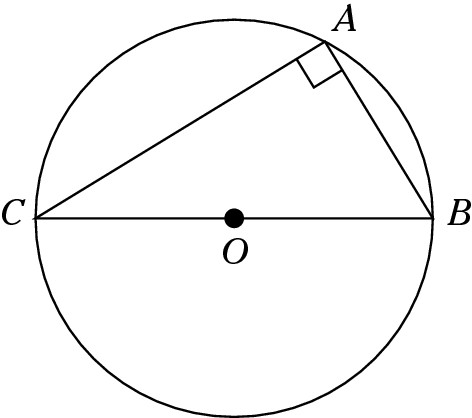
1. The radius of the circle is 1, and AB = 1.
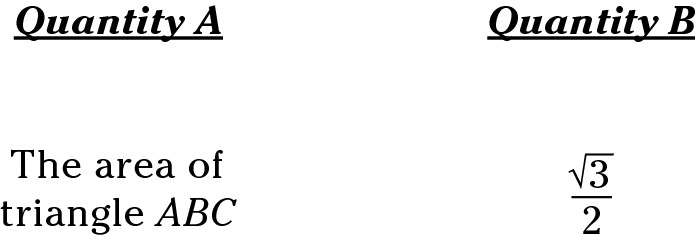
2. The average (arithmetic mean) of ten test scores is 120, and the average of 20 additional test scores is 90.

3. 10 < n < 15 and d = 20
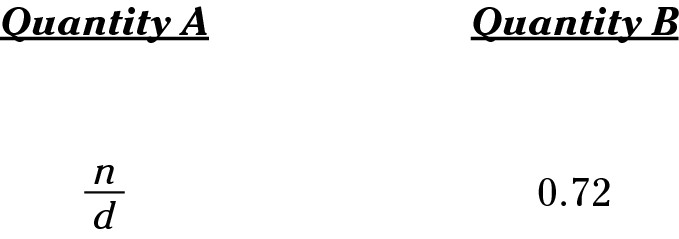
4. A certain recipe requires  cups of lentils and makes six servings.
cups of lentils and makes six servings.
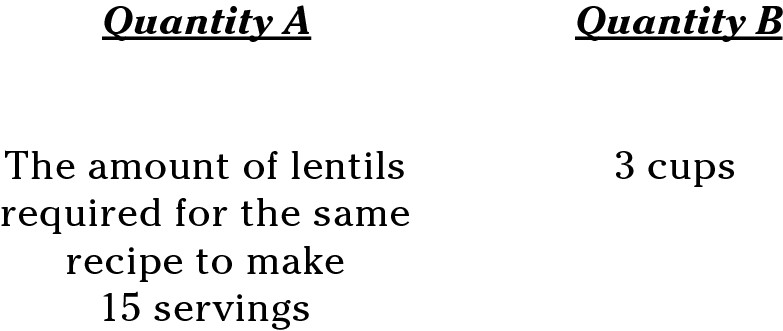
5.


6.
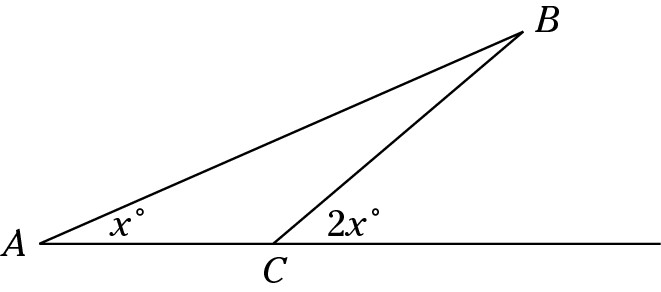

7. x2 – x – 6 = 0
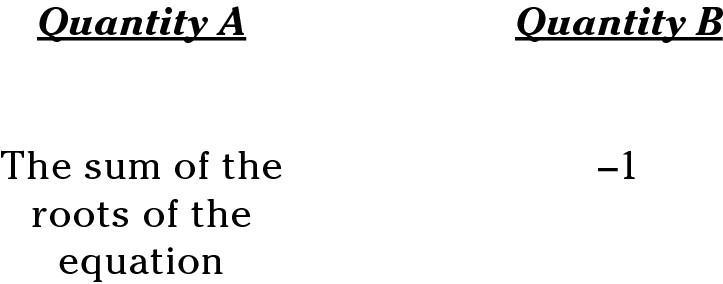
8. Set S contains the numbers 3, 4, 5, 6, 7, and 8.

9. What is the units digit of 219,473 × 162,597?
A 1
B 2
C 3
D 4
E 5
10. In the xy plane, what is the slope of the line whose equation is 2x + 3y = 5?
A 1
B 
C 
D 
E 
11. Bill is budgeting the expenditure of a new car based on his gross income from last year. If his gross income from last year was $50,000 and Bill wants to spend between 15% and 30% on a new car, which of the following could be the cost of the new car?
Indicate all possible costs of the new car.
A $8,000
B $10,000
C $12,000
D $14,000
E $16,000
F $18,000
12. If the sporting center has 2 baseballs for every 9 baseball gloves, and 3 baseball bats for every 5 baseballs, what is the lowest number of sporting items that could be in the sporting center?

13. If the average of x, y, and z is 5, what is the average of 4x + y, 2y – x, and 3z + 27?

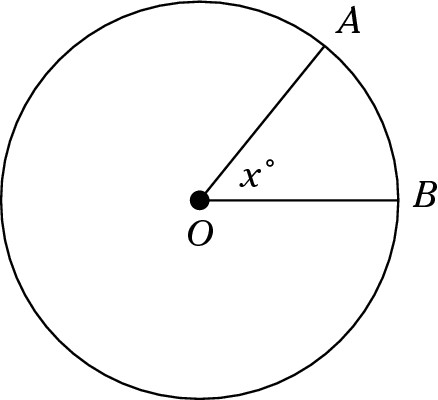
14. The circle shown has the center O and a radius of 8. If x = 45, what is the length of minor arc AB?
A 
B π
C 
D 2π
E 
Questions 15–17 are based on the following data.
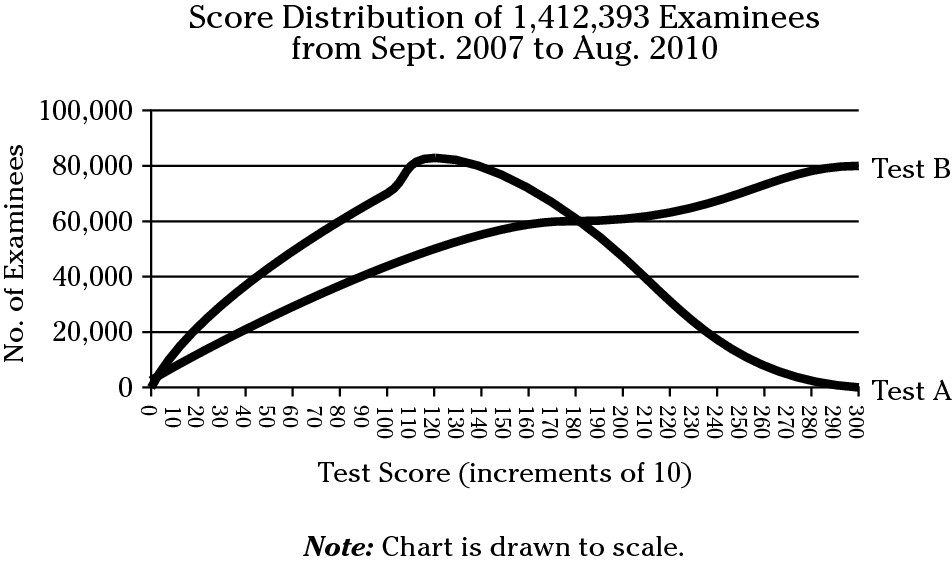
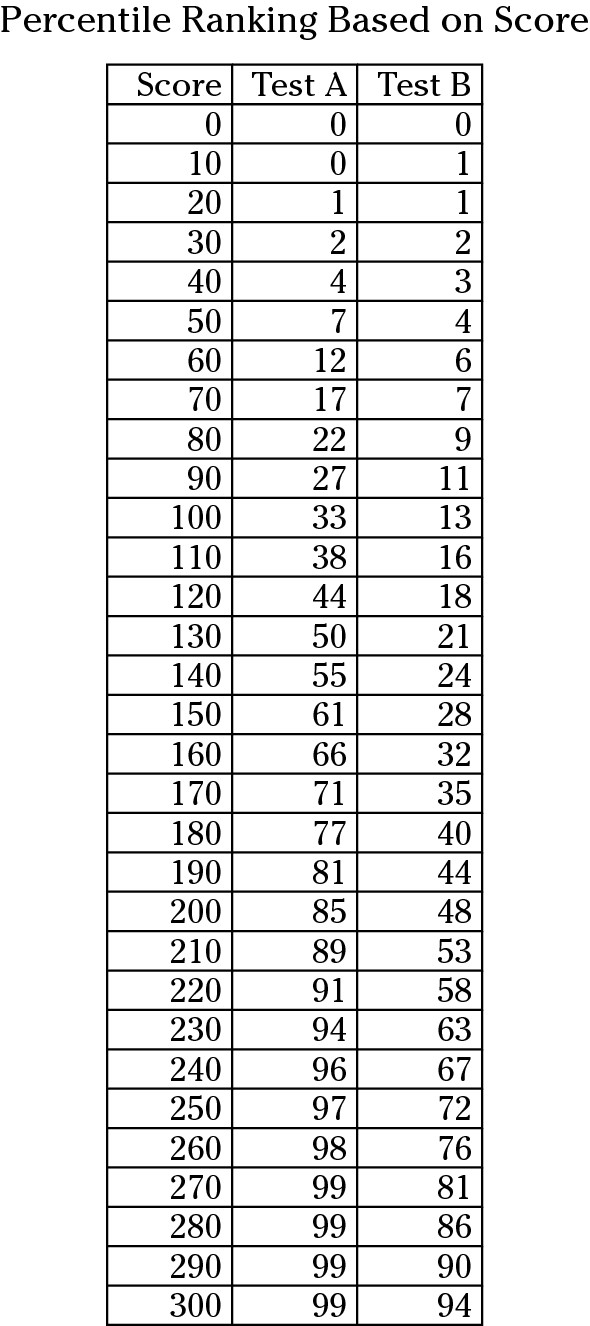
15. Approximately what ratio of examinees taking Test B scored a perfect 300?
A 1 out of 100
B 1 out of 90
C 1 out of 50
D 1 out of 20
E 1 out of 10
16. If a Test A examinee is among a group of 40,000 examinees with the same score, what could be the examinee’s score?
A 20
B 40
C 90
D 180
E 210
17. A Test A examinee improving his score from 100 to 120 surpasses approximately how many other examinees?
A 40,000
B 80,000
C 155,000
D 240,000
E 300,000
18. The radius r of a circle increases by 50%. In terms of r, what is the area of the circle with the increased radius?
A 
B 2πr2
C 
D 3πr2
E 
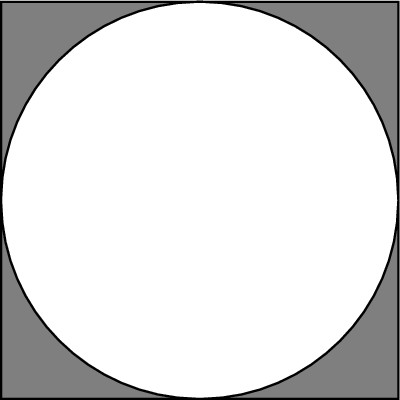
The circle is inscribed within the square of area 36.
19. In the preceding drawing, what fraction of the square is occupied by the circle?
A 
B 
C 
D 
E 
20. What is the radius of a right circular cylinder with a volume of 50π and a height of 2?


Section 3
Verbal Reasoning
Time: 30 minutes for 20 questions
Directions: Choose the best answer to each question. Blacken the corresponding oval(s) on the answer sheet.
Directions: For Questions 1–7, choose the one entry best suited for each blank from its corresponding column of choices.
1. The Oxford English Dictionary consists of 20 _____, is 21,728 pages long, and weighs in at about 143 pounds.
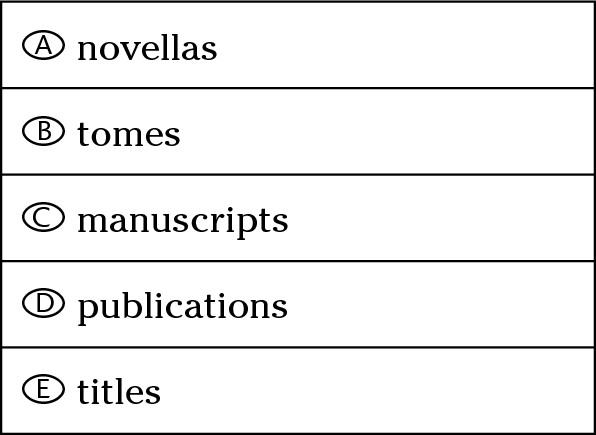
2. The neighbors were so incredibly _____, that within six weeks, the couple decided to move somewhere more remote.
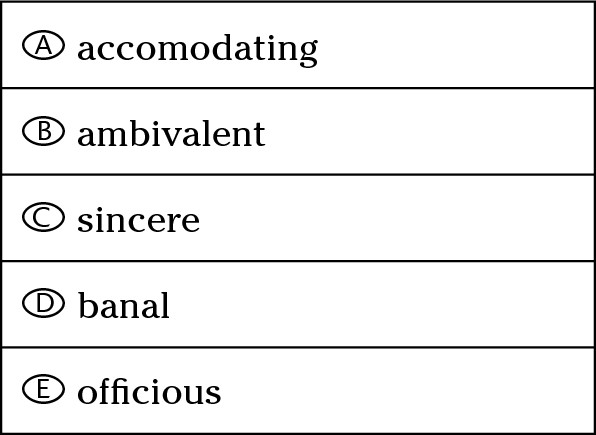
3. More than 50 percent of online shoppers abandon their shopping carts simply because they’ve changed their minds, proving just how (i)_____ they can be. Many online merchants have observed shoppers’ (ii)_____ for failing to complete their transactions.
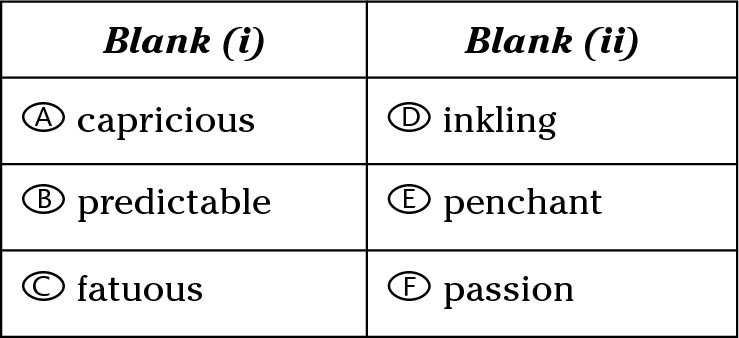
4. Because his salary and benefits were (i)_____ with the time and effort he expected to invest in the project, Jerry decided not to (ii)_____ over the deadlines.
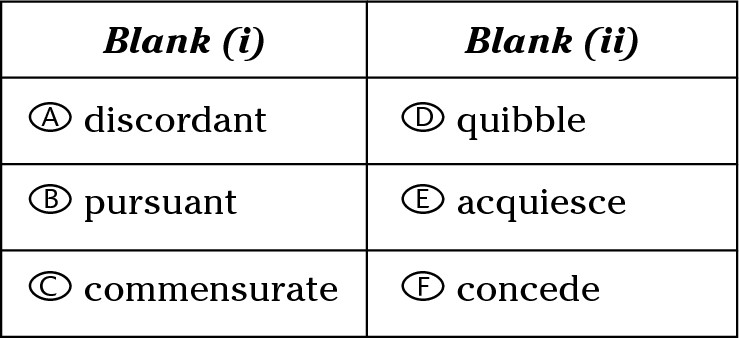
5. By the time the speaker approached the microphone, the impatient audience was (i)_____. Everything he said in an attempt to silence the rabble only seemed to (ii)_____ the situation.
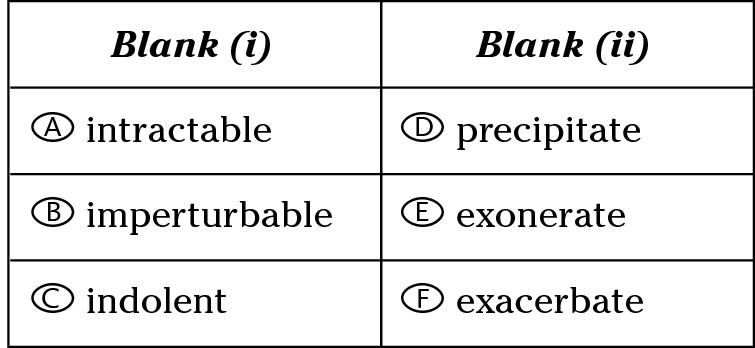
6. With the accidental addition of the (i)_____, the mixture became very (ii)_____. Knowing that student safety (iii)_____ all other concerns, the teacher ushered her students out of the lab.

7. When asked whether the antique vase was in (i)_____ condition, its owner (ii)_____ that it certainly was. When the buyer received it, however, she discovered that she had been (iii)_____.

Directions: Each of the following passages is followed by questions pertaining to the passage. Read the passage and answer the questions based on information stated or implied in that passage. For each question, select one answer choice unless instructed otherwise.
The following passage is an excerpt from Carnegie by Peter Krass (Wiley).
Great Britain had taken an early lead in the Industrial Revolution. The isles, with rich coalfields to provide fuel for steam engines, many natural waterways for cheap transportation, and a booming international trade with its colonies, was ideally suited for a transformation from an agricultural-based economy to a manufacturing-based economy, from a handicraft system to a factory system. As country folk, in search for steady jobs, migrated to the cities in increasing numbers, the transition proved painful because already poor living conditions in urban centers were exacerbated by a population explosion. Contributing to this unprecedented growth were the Irish, who, seeking work, arrived in waves. Thus, employers had such a large labor pool to select from that they were able to dictate low wages and long hours, further suppressing the working poor. Disillusioned and embittered, the working class formed both trade and political unions to exert pressure, and activism increased dramatically.
For the following question, consider each answer choice separately and select all answer choices that are correct.
8. Which of the following is specifically cited as contributing to Great Britain’s ability to take an early lead in the Industrial Revolution?
A Trade unions
B International trade
C Abundance of coal
For Questions 9–12, select only one answer choice.
9. Which one of the following sentences most clearly explains why wages were so low?
A Sentence 2: “The isles . . . factory system.”
B Sentence 3: “As country folk . . . population explosion.”
C Sentence 4: “Contributing . . . arrived in waves.”
D Sentence 5: “Thus, employers . . . working poor.”
E Sentence 6: “Disillusioned and embittered . . . increased dramatically.”
10. Which of the following would make the most accurate title for this passage?
A Great Britain’s Industrial Revolution: From Boom to Bust
B Exploitation of the Poor during Great Britain’s Industrial Revolution
C The Birth of Unions in the Industrial Revolution
D Britain’s Industrial Revolution from the Eyes of the Poor
E Great Britain’s Industrial Revolution: Natural Resources, Migration, and Unions
The current trend to hold teachers accountable for the failures of our school systems and students is nothing more than a blame game that makes teachers the scapegoats. Even with the passage of No Child Left Behind, which was intended to make our schools and teachers more accountable, students in the U.S. continue to underperform students in other countries in math and science. If we are to get serious about education in the United States, we need to hold everyone accountable, not only schools and teachers, but also students, parents, and society at large. As long as sports, celebrity worship, television, video games, and consumerism are higher on our list of priorities than education, academic performance will continue to decline.
11. Which of the following, if true, most effectively undermines the argument that holding teachers accountable is not a solution to improving student academic performance?
A A study conducted at one school found that students of some of the teachers showed significant improvement year after year while students of other teachers at the same school did not.
B Socio-economic differences among students contribute significantly to student performance.
C Studies show a direct link between school funding and student performance.
D With the passage of No Child Left Behind, students of teachers who teach to the test perform significantly better on standardized tests.
E The decline in SAT scores from 1975 to 1990 can be attributed to the fact that more lower-ranking students now take the test.
Many argue that at the root of the most serious threats to human existence is overpopulation. Putting the blame solely on overpopulation, however, is oversimplified. You also need to account for consumption. For example, Americans constitute 5 percent of the world’s population but consume 24 percent of its energy. While more than half of the world’s population lives on 25 gallons of water per day, the average American uses 159 gallons daily. In addition, 56 percent of the available farmland is used for beef production. That overconsumption is a far bigger problem than overpopulation is obvious.
12. Which of the following is most effective in countering the argument that overconsumption is a bigger problem than overpopulation?
A The world population doubles every 40 years.
B Consumption rates are on the rise in developing countries.
C Population growth offsets any savings in resources from improved efficiency as well as gains in per-capita consumption reduction.
D As average incomes rise, per capita consumption also increases.
E One-third of the population living in South Asia and sub-Saharan Africa account for only 3.2 percent of consumer spending.
This passage is an excerpt from Film Theory: An Introduction by Robert Stam (Wiley-Blackwell).
There are many possible ways to describe the history of film theory. It can be a triumphant parade of “great men and women”: Munsterberg, Eisenstein, Arnheim, Dulac, Bazin, Mulvey. It can be a history of orienting metaphors: “cine-eye,” “film language,” “window on the world,” camera-pen,” “film language,” “film mirror,” “film dream.” It can be a story of the impact of philosophy on theory: Kant and Munsterberg, Mounier and Bazin, Bergson and Deleuze. It can be a history of cinema’s rapprochement with (or rejection of) other arts: film as painting, film as music, film as theater (or anti-theater). It can be a sequence of paradigmatic shifts in theoretical/interpretive grids and discursive styles — formalism, semiology, psychoanalysis, feminism, cognitivism, queer theory, postcolonial theory — each with its talismanic keywords, tacit assumptions, and characteristic jargon.
For Question 13, select only one answer choice.
13. In the context of this passage, which of the following is the best synonym for the word rapprochement?
A relationship
B reconciliation
C disapproval
D agreement
E harmony
For the following question, consider each answer choice separately and select all answer choices that are correct.
14. Which of the following does the author list as possible ways to describe the history of film theory?
A History of psychoanalysis
B History of film language
C Triumphant parade of great men and women
Directions: Each of the following sentences has a blank indicating that a word or phrase is omitted. Choose the two answer choices that best complete the sentence and result in two sentences most alike in meaning.
15. Among her peers, Amanda was known as the life of the party, but during the graduation ceremony, her antics made her appear _____.
A courteous
B loutish
C decorous
D capricious
E boorish
F contentious
16. The manager’s plans were so _____ that nobody on his staff could figure out exactly what they were supposed to be doing.
A straightforward
B desultory
C methodical
D convoluted
E proscribed
F tortuous
17. While citizens were demanding strong leadership, the _____ candidates continued to pander to the polls.
A pusillanimous
B impudent
C audacious
D sanctimonious
E craven
F intransigent
18. Although parents are often reluctant to _____ their children, they know it is their duty to do so.
A sanction
B admonish
C vilify
D disparage
E castigate
F congratulate
19. The department of transportation offered the _____ couple double the market value of their home, but they continued to refuse to move out.
A obdurate
B recalcitrant
C implacable
D assiduous
E subversive
F fundamentalist
Directions: The following passage is followed by a question pertaining to the passage. Read the passage and answer the question based on information stated or implied in the passage. Select only one answer.
This passage is an excerpt from Art in Theory: 1900–2000: An Anthology of Changing Ideas edited by Charles Harrison and Dr. Paul J. Wood (Wiley-Blackwell).
In Naturalist theories the effect of the work of art was supposed to be traceable back into the world. That it had its origin in that world — or some direct experience of it — was the guarantee of the work’s authenticity. In forms of theory subject to the gravitational pull of Symbolism, on the other hand, the effects of art were signs of the authenticity of an inner life; they were understood, that is to say, as originating in the mind or soul of the artist. There were some clear implications of this position. With the abandonment of naturalistic correspondence as a criterion, a premium was placed on the strength and authenticity of individual responses and feelings. A requirement of vividness of expression tended to supplant the traditional requirement of accuracy of description.
20. Which of the following comparisons is the main focus of this passage?
A Art versus nature
B Description versus expression
C Mind versus soul
D Theory versus reality
E Authenticity versus vividness

Section 4
Quantitative Reasoning
Time: 35 minutes for 20 questions
Notes:
 All numbers used in this exam are real numbers.
All numbers used in this exam are real numbers.
 All figures lie in a plane.
All figures lie in a plane.
 Angle measures are positive; points and angles are in the position shown.
Angle measures are positive; points and angles are in the position shown.
Directions: For Questions 1–7, choose from the following answer choices:
A Quantity A is greater.
B Quantity B is greater.
C The two quantities are equal.
D The relationship cannot be determined from the information given.
1. A furniture dealer sold two sofas for $400 each, for a 25% profit on one and a 20% loss on the other.

2. n is a positive integer between 200 and 500
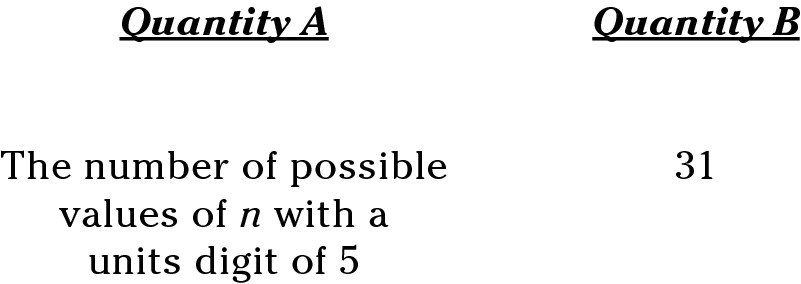
3. ab < 0

4. 
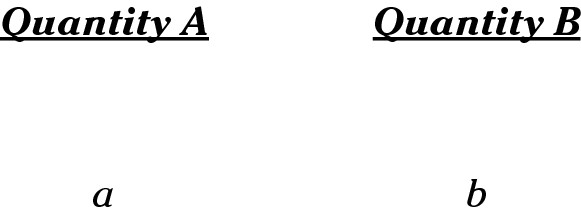
Questions 5 and 6 are based on the following information:
Square ABCD is in the xy-coordinate plane, and each side of the square is parallel to either the x-axis or the y-axis. Points A and C have coordinates (–2, –1) and (3, 4), respectively.
5.
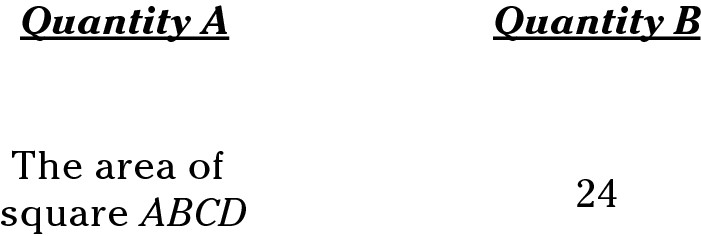
6.

7. n > 0
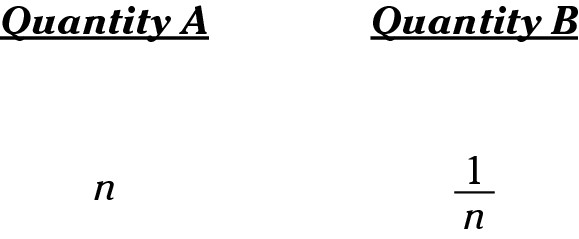
8. A car travels at a constant rate of 20 meters per second. How many kilometers does it travel in 10 minutes? (1 kilometer = 1,000 meters.)
A 5
B 12
C 15
D 20
E 25
9. If (x – 5)2 = 900, what are the two possible values for x?
Indicate two such numbers.
A 10
B –10
C –25
D 30
E 35
F 40
10. A circular pool of radius r feet is surrounded
by a circular sidewalk of width  feet. In
feet. In
terms of r, what is the area of the sidewalk?
A 2πr2
B 
C 
D πr2
E 
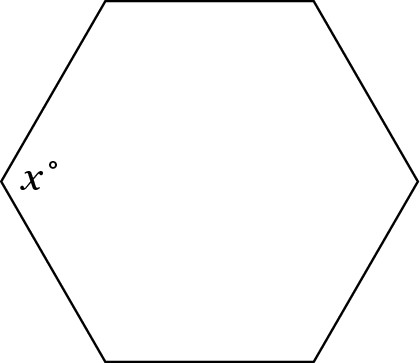
11. The preceding figure shows a regular hexagon. What is the value of x?

12. If n divided by 35 has a remainder of 3, what is the remainder when n is divided by 7?

13. If the length of a rectangle were increased by 20% and the width were decreased by 20%, what is the ratio of the original area to the new area?
A 4:3
B 5:4
C 10:9
D 15:13
E 25:24
Questions 14–16 are based on the following data.
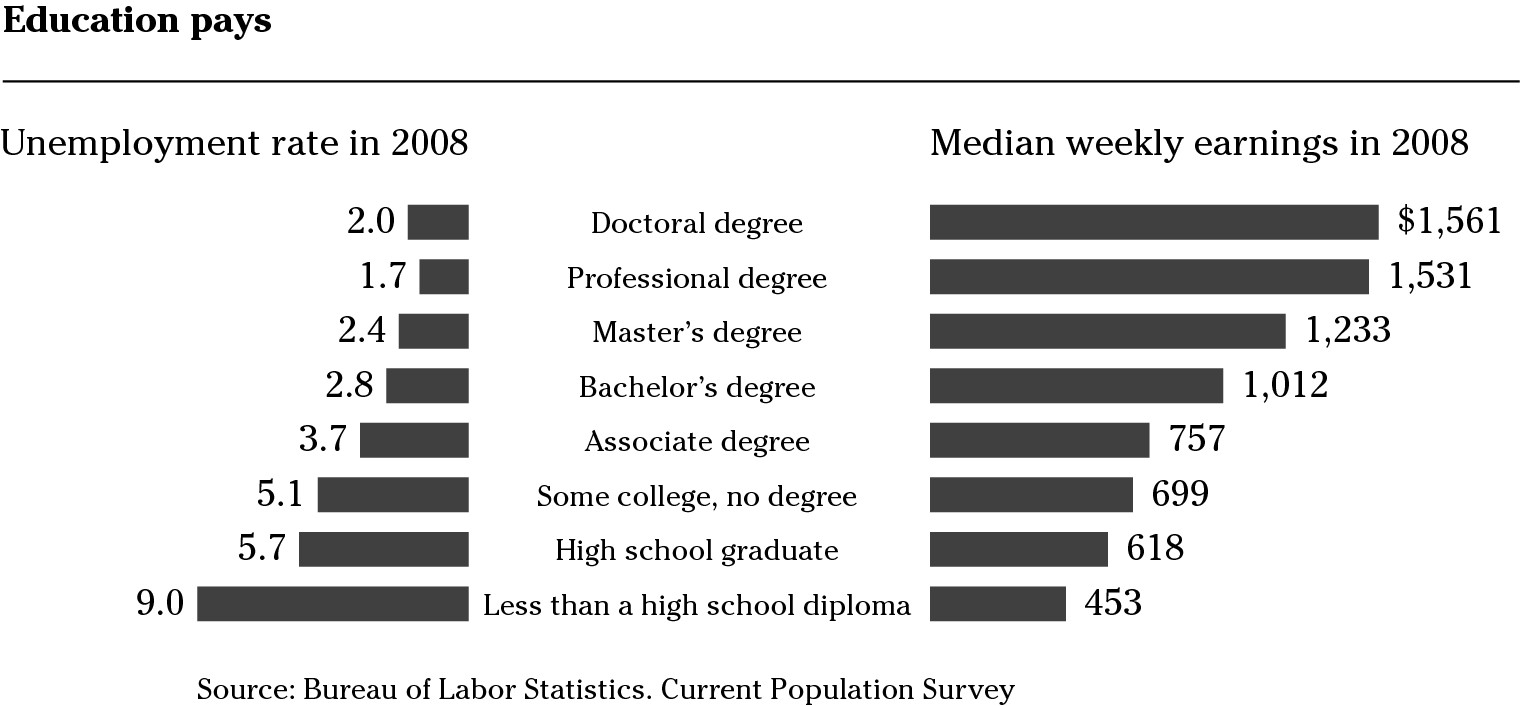
14. Approximately what were the median monthly earnings of someone with a Bachelor’s degree in 2008?
A $1,012
B $1,233
C $4,050
D $4,350
E $4,750
15. In 2008, if there were 10,000 Doctoral-degree holders and 200,000 Master’s-degree holders, what was the ratio of unemployed Doctoral-degree holders to unemployed Master’s-degree holders?
A 1:20
B 1:24
C 1:48
D 1:50
E 1:200
16. If an Associate-degree holder earning 20% less than the median for that degree went on to get a Bachelor’s degree and earn 25% more than the median for that degree, which of the following is closest to the change in the degree holder’s annual income?
A $28,200
B $30,500
C $31,500
D $34,300
E $49,500
17. What is the area of an equilateral triangle with a base of 6?
A 
B 
C 
D 
E 
House Values of a Neighborhood in Town X
|
Value Range (In Thousands of Dollars) |
Number of Houses |
|
Under $100 |
6 |
|
$100–$149 |
14 |
|
$150–$199 |
12 |
|
$200–$250 |
10 |
|
Over $250 |
7 |
18. For the 49 houses from the neighborhood in Town X, which of the following could be the median value, in thousands of dollars?
Indicate all such values.
A $148
B $162
C $170
D $195
E $210
F $225
19. Two lines represented by the equations y = x + 3 and y = 2x + 5 intersect at point P. What are the coordinates of P?
A (–2, 1)
B (–1, 2)
C (1, –2)
D (2, –1)
E (1, 2)
20. 
A 0
B 1
C 5
D 25
E 125
